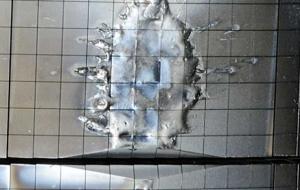Generating runaway electrons in JET to benefit ITER
11 Jul 2015
-
EUROfusion
Like splashes of water: re-deposited, molten beryllium appears on tiles inside the JET vessel after dedicated experiments.
Recent images of JET interior tiles have shown, in graphic detail, the damage that can be caused by so-called 'runaway' electrons in JET plasmas.
In stable fusion plasmas, fast moving electrons are slowed down by collisions. The balance between acceleration and slowingdown due to collisions ensures that under usual circumstances the electrons have a normal thermal distribution of velocities within the confined plasma.
However, there are certain circumstances—especially just after a plasma has terminated or disrupted — where the 'slowing down' effect of collisions is diminished and indeed largely removed. In this situation, JET acts like a particle accelerator enabling 'runaway' electrons to be accelerated to velocities close to the speed of light.
When the beams of runaway electrons hit the beryllium wall tiles they can travel many centimetres through the material producing characteristic melt pools like the one shown here. Special experiments are designed in JET to create and understand the formation of runaway beams. Fortunately, since installation of JET's ITER-like Wall such events do not occur naturally and have to be deliberately generated for such studies.
The JET experiments are providing ITER with vital information on which strategies are effective at mitigating this threat.


